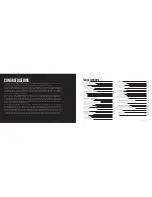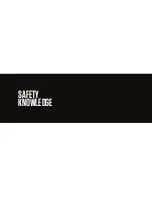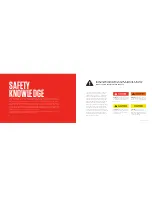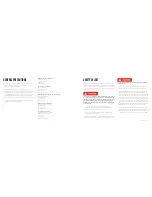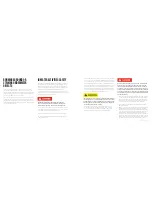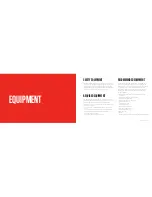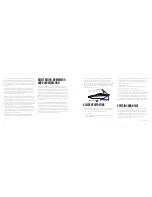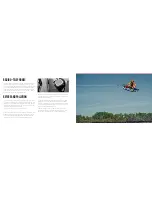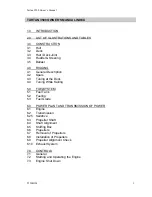
2017 OWNERS MANUAL /
10
EMERGENCY TREATMENT
FOR CO POISONING
CO poisoning or toxicity is a life-threatening emergency that
requires immediate action. The following is a list of things that
should be done if CO poisoning is suspected. Proceed with caution.
The victim may be in an area of CO concentration, which means you
or others could be in danger from exposure to CO:
• Evaluate the situation and ventilate the area if possible.
• Evacuate the area and move the affected person(s) to a fresh
air environment.
• Observe the victim(s).
• Administer oxygen, if available.
• Contact medical help. If the victim is not breathing, perform
rescue breathing or approved cardiopulmonary resuscitation
(CPR) as appropriate until medical help arrives. Prompt action can
mean the difference between life and death.
• Shut off potential sources of CO, if possible. Correct ventilation
problems and/or repair exhaust problems as appropriate.
Investigate the source of CO and take corrective action, such as
evacuating and ventilating the area or shutting off the source
of the CO, while at the same time evacuating and ventilating the
area.
to do so can result in the accumulation of CO fumes.
• Never sit, teak surf, or hang on the back deck or swim platform
while the engine is running. Teak surfing is NEVER a safe activity.
• Never move into areas under swim platforms where exhaust out-
lets are located unless the area has been properly ventilated.
• Operation of boats at mile-high (5,250 ft.) or higher altitudes may
affect CO production. Check with an authorized MasterCraft deal-
er before operating at higher altitudes to determine whether the
engine may require additional tuning to prevent excessive CO.
• Although CO can be present without the smell of exhaust fumes,
if you smell exhaust fumes, CO is also present. Take immediate
action to dissipate these fumes.
• Treat symptoms of seasickness as possible CO poisoning. Get
the person(s) into fresh air immediately. Seek medical attention.
• Install and maintain CO alarms inside your boat. Do not ignore any
alarm. Replace alarms as recommended by the manufacturer.
• Follow Coast Guard safety checklists.
• Get a Vessel Safety Check. They are free! Your local U.S. Coast
Guard Auxiliary can provide details or check www.uscgaux.org
online to locate assistance.
WHERE CO MAY ACCUMULATE
Carbon monoxide can accumulate anywhere in or around your boat.
This includes, but is not limited to:
• Inadequately ventilated canvas enclosures.
• Exhaust gas trapped in enclosed places.
• Blocked exhaust outlets.
• Another vessel’s exhaust. CO from the boat docked next to you
can be just as deadly as that emitted from your own boat.
• Back drafting from your own boat’s exhaust.
• At slow speeds, while idling or stopped. Be aware that CO can
remain in or around your boat at dangerous levels even if your
engine or the other boat’s engine is no longer running.
HOW TO PROTECT YOURSELF
AND OTHERS
Follow these simple steps to help keep CO from poisoning you, your
passengers and others nearby:
• Know where and how CO may accumulate in and around your
boat. This is particularly important when starting or running
engines in boathouses, or near a sea wall. Boats that are moored
in close proximity are also potential problems as the fumes from
your boat or another boat can affect air drafts on all boats. Back
drafting sometimes called the “station wagon effect” occurs
when the fumes curl up over the swim platform and transom and
into the boat, especially when canvas or other coverings trap the
fumes. Even in open air, consider wind direction, the boat’s speed
and trim angles.
• Maintain fresh air circulation throughout the boat at all times. CO
concentration is greater when the engine is cold. Ensure the boat
is situated to take advantage of maximum dissipation of fumes.
• If your boat is equipped with a generator, know where the exhaust
outlet(s) is located and keep everyone away from the area.
• Ensure that appliance, air conditioning, heater, generator, or other
on-board function that emits fumes is routinely and regularly pro-
vided with maintenance as described by manufacturers. Failure
Summary of Contents for NXT20 2017
Page 3: ...2017 OWNERS MANUAL SAFETY KNOWLEDGE ...
Page 27: ...2017 OWNERS MANUAL 48 2017MODEL FEATURESANDSPECS ...
Page 40: ...2017 OWNERS MANUAL 74 DASHESAND VIDEOSCREENS ...
Page 42: ...2017 OWNERS MANUAL 78 XANDXTSERIESINSTRUMENTPANEL 4 3 VIDEOSCREEN XSTARINSTRUMENTPANEL ...
Page 43: ...2017 OWNERS MANUAL 80 PROSTARINSTRUMENTPANEL NXTSERIESINSTRUMENTPANEL ...
Page 58: ...2017 OWNERS MANUAL 110 XANDXTSERIES VIDEOSCREEN OPERATIONSHV450 ...
Page 67: ...2017 OWNERS MANUAL 128 XSTAR VIDEOSCREEN OPERATIONS XSTARINSTRUMENTPANEL ...
Page 80: ...2017 OWNERS MANUAL 154 PROSTAR VIDEOSCREEN OPERATIONS ...
Page 97: ...2017 OWNERS MANUAL 188 NXT OPERATIONS ...
Page 101: ...2017 OWNERS MANUAL 196 NXT20 22 VIDEOSCREEN OPERATIONS ...
Page 107: ...2017 OWNERS MANUAL 208 BOAT OPERATIONS ...
Page 158: ...2017 OWNERS MANUAL 310 PREPARATION ...
Page 172: ...2017 OWNERS MANUAL 338 CAREAND MAINTENANCE ...
Page 204: ...2017 OWNERS MANUAL 402 TRAILERS ...


